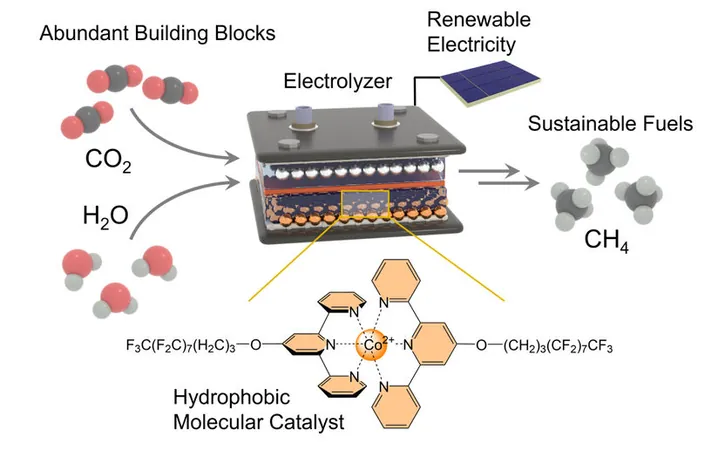
Revolutionary Catalyst Turns Electricity into Methane—A Game Changer for Renewable Energy!
2024-10-08
Author: Li
Imagine a world where electricity not only powers our gadgets but also helps produce clean, eco-friendly methane!
This is exactly what Prof. Dr. Nikolay Kornienko and his team are achieving at the Institute of Inorganic Chemistry at the University of Bonn. After transitioning from the University of Montreal, Kornienko has been at the forefront of a groundbreaking study that utilizes electricity as a catalyst for producing methane, defying traditional methods that relied heavily on heat or pressure.
Turning Carbon Dioxide into Fuel: A Complex Dance
The chemical reaction to create methane (CH4) is no walk in the park. It requires the careful combination of carbon dioxide (CO2) and water (H2O). Kornienko explains that the challenge lies in the need to separate two oxygen atoms from the carbon atom and efficiently replace them with four hydrogen atoms sourced from water. This intricate process not only addresses energy needs but could significantly impact global warming.
Innovation at Work: A Catalyst with a Twist
By employing a gas diffusion electrode, Kornienko's team ensures that CO2 and water can react without interference from unwanted side reactions. In typical scenarios, water attempts to break down into hydrogen and oxygen when electricity is applied, complicating the effort to produce methane. To circumvent this issue, the newly developed catalyst plays a crucial role.
The catalyst features an innovative “active center” that captures carbon dioxide while simultaneously preventing water from contact that could lead to side reactions. To achieve this, long chemical chains known as hydrophobic side chains are attached to the active center. These chains repel water and act like a conveyor belt, delivering hydrogen atoms straight to the carbon for conversion into methane.
Impressive Efficiency Rates and Future Applications
Remarkably, this new catalyst boasts an efficiency rate of over 80%, producing minimal unwanted byproducts. While it’s not quite ready for industrial-scale methane production yet, Kornienko asserts that the principles demonstrated could be adapted for various materials, paving the way for large-scale applications in the future.
But methane production isn’t the limit! Kornienko envisions his catalyst method extending to other valuable chemicals, with ethylene—commonly used in plastics—being a primary candidate. This could potentially revolutionize plastic manufacturing, contributing to a more sustainable and environmentally conscious industry.
The Future is Bright: Sustainable Energy Solutions on the Horizon
With the world facing urgent environmental challenges, innovative solutions like this catalyst have the potential to reshape our energy landscape. Kornienko's work in utilizing electricity for the green production of methane ensures that the journey toward sustainable energy is not just a dream but a tangible reality that could profoundly benefit our planet.
Stay tuned, as we follow this exciting development that might just hold the key to a cleaner, greener future!



 Brasil (PT)
Brasil (PT)
 Canada (EN)
Canada (EN)
 Chile (ES)
Chile (ES)
 España (ES)
España (ES)
 France (FR)
France (FR)
 Hong Kong (EN)
Hong Kong (EN)
 Italia (IT)
Italia (IT)
 日本 (JA)
日本 (JA)
 Magyarország (HU)
Magyarország (HU)
 Norge (NO)
Norge (NO)
 Polska (PL)
Polska (PL)
 Schweiz (DE)
Schweiz (DE)
 Singapore (EN)
Singapore (EN)
 Sverige (SV)
Sverige (SV)
 Suomi (FI)
Suomi (FI)
 Türkiye (TR)
Türkiye (TR)